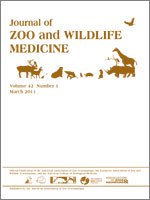Facial abscessation and osteomyelitis due to dental disease is commonly seen in the Malayan tapir (Tapirus indicus), but little is known about the prevalence or etiology of these lesions. To determine the prevalence of dental ailments, 56 skulls and mandibles of deceased Malayan tapirs were visually and radiographically evaluated. Dental lesions were scored according to severity, and individuals were classified according to their age (juvenile/young adult/adult) and origin (captive/free ranging). All of the lesions identified were of a resorptive nature, seemingly originating at the cementoenamel junction and burrowing towards the center of the tooth. Overall, 27% of the investigated skulls presented radiolucent dental lesions. The prevalence among captive animals was 52% (13/25), while only 6% (2/31) of the free-ranging tapirs had dental lesions. The second, third, and fourth premolars and first molar were the teeth most commonly affected, and the mandibular teeth were more often involved than the maxillary dentition. This study demonstrates a high prevalence of resorptive dental lesions in captive Malayan tapirs and provides a strong indication that age and captivity are significant risk factors in the development of these lesions.
How to translate text using browser tools
1 March 2011
Resorptive Tooth Root Lesions in the Malayan Tapir (Tapirus indicus)
Mari-Ann O. Da Silva,
Hanne E. Kortegaard,
Siew Shean Choong,
Jens Arnbjerg,
Mads F. Bertelsen
ACCESS THE FULL ARTICLE
dental disease
Malayan tapir
radiology
resorptive lesions
Tapirus indicus





